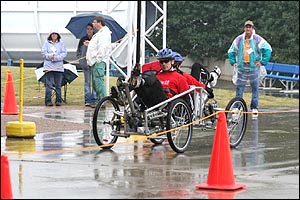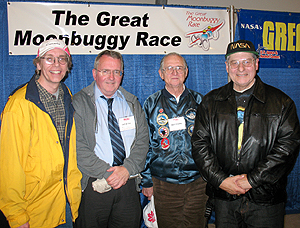This year's 14th Annual Great Moonbuggy Races in Huntsville Alabama at the US Space and Rocket Center marked the very first time the event became international. A German high school and a Canadian University, Carleton University from Ottawa Canada participated. Over the two day event, 47 High School and University teams put their 2 person human-powered moonbuggies to the test on the 1.1 km course which was full of obstacles and simulated lunar terrain. Our Canadian group competed against 21 other University teams.

Team Carleton riders Joel Spark and Jessica Keranen
I became aware of the event in late 2004 when I was invited to attend the 2005 races by a friend of mine, Ron Creel. Ron was one of the design members of the Apollo Lunar Rover and helped me with my 3D lunar rover project and was also an official at the races. I unveiled my lunar rover poster at the races and gave every entrant a copy. (Read more about
my visit to the 2005 races and my 3D
lunar rover project. My poster is now for sale in the gift shop at the US Space and Rocket Center.)
I was so impressed with the event and how it inspired the students and supporters that I wanted to bring a team from Canada the next year. A couple of friends of mine from the video world had travelled with me to the 2005 races. I put together a pitch video that gave an extensive overview of the event and the course. I included 3d animations of the course and interviews with participating team members. They spoke of their experiences on the course and how they would change/modify their designs for the next year. All of this was useful for a team wanting background and .

Team Carleton negotiating obstacle #1
For the rest of that year I pitched my idea to a number of schools. Then came some very bad news. The 2006 races were officially cancelled. I felt the lose of this event would be a tragic mistake. A good friend and I set up a petition on my website to "save the races". Along with our petition signatures and comments, teachers from across the US flooded NASA with pleas to save the races. Thankfully Northrop Grumman Corporation stepped in and became the race's main sponsors. The races were on again and were a great success in April of 2006.
I continued my search and in the fall of 2006 I pitched my idea to Carleton University's Students for the Exploration and Development of Space (CuSEDS) then President Grant Bonin. He like the idea and next I spoke with the members of the group. They all were enthusiastic and signed onboard.
I was very happy the students agreed because Carleton was my alma mater. The university had a number of unique ties to the space program. In the mid 1970's one of the Lunar Rover's father's and wheel designers Dr. Mieczyslaw Bekker taught at Carleton. He was an authority on land vehicle locomotion and worked alongside Carleton Professor Joe Wong. Professor Wong is still lecturing to NASA and space workers about rover technology. Another link to the space program is former astronaut Marc Garneau. Dr. Garneau was Canada's first astronaut, President of the Canadian Space Agency and Carleton's Chancellor. Carleton seemed to be the perfect choice.

Don McMillan and LRV team members (L-R) Ron Creel, Otha "Skeet" Vaughan Jr., and Saverio "Sonny" Morea.
I spent the next 8 months attending meetings and passing along as much information as I could. The most important suggestion I made was stressing physical training. The 2005 races revealed that many teams spent a lot of time on construction but little or no physical training for the grueling 1.1 km ride. Many riders were totally exhausted once the race was over. The winning college team in 2005 was Utah State. Their design allowed them to traverse the many obstacles and terrain. Both riders were also in tip top shape. Our team spent many long hours working on the buggy as well as physical training.
I arrived on the thursday and visited with Ron Creel and his family, Otha Skeet Vaughan and Author Anthony Young. Friday I visited the UAH and spent part of the day looking over Sonny Morea's extensive archive material from his LRV days. The archives holds an impressive array of papers and material that documented the entire rover program. Author Anthony Young spent much time there researching for his latest book "Lunar and Planetary Rovers: The Wheels of Apollo and the Quest for Mars". His book is a great overview of the rover program and has interviews with the astronauts, LRV design team members and fantastic seldom seen photos from the program. Anthony kindly put one of my 3D rover images in his book. Visit his book website
here and to order his book visit Amazon
here.
Race day Saturday welcomed rain.. buckets and buckets of it.. we had severe weather warnings all day long and the races were a constant "go" or "no-go". Canada's Discovery Channel's Daily Planet followed our team for the day and recently aired the story. Visit here.
I reminded our team they couldn't give up or quite no matter what. It was very important to finish the race. Our vehicle unfortunately didn't get through the first obstacle but that didn't stop our brave drivers Joel Spark and Jessica Keranen. They got out and pushed the vehicle around the entire course. Later at the awards show our team won the "crash and burn award" which was given for sheer determination and spirit. It was a flotation jacket which flew on 3 space shuttle flights and will be passed along to each new team. As was reminded often by the aerospace representatives "you learn more from your failures than from your successes." All of the teams participating took these words to heart.
After the awards show, our students were approached by Northrop Grumman Corporation, the event's major sponsor. The official asked everyone interested to submit their resumes for the opportunity to intern with the aerospace company. An event such as this gives students the opportunity to meet with the sponsors who are all from the aerospace industry. The event also gives potential employers a chance to see the enthusiasm and commitment the students display.
Our team also had the chance to visit the space center's museum and experienced, close-up, actual space hardware which put us into space, on the moon and beyond. They all had the opportunity to speak with Ron, Sonny and Skeet and came to realize many of these space veterans were not much older than our team when they first started working in the space program. For these future aerospace engineers the event was a tremendous success.
Our team has the "most improved" award in their sights. I am now looking for a high school team in the hopes we can take them with us next year.
Special thanks to Durlean Bradford and all the organizers for this year's race. Check out more information about the Great Moonbuggy Races at the Marshall Space Center site
here. We also want to thank everyone who supported our team in this year's race. Please visit
here to read their names and read about more about the races.
Read a short NASA website article about the 2005 races
here.





